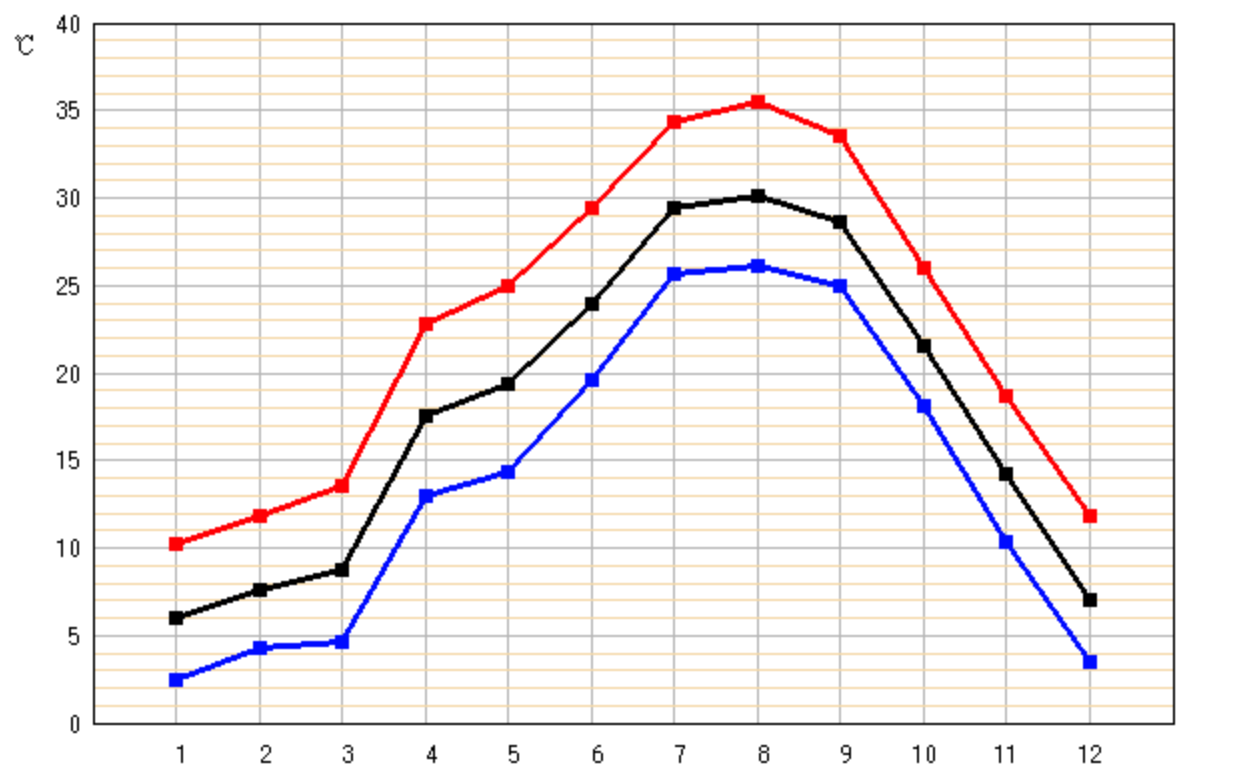Travel Tips
Weather & Clothing
Kyoto has four distinct seasons, each with very different conditions. In spring, people gather outside to admire the cherry blossoms, while fall attracts visitors with its vibrant foliage. Whether in summer or winter, it is possible to go on an enjoyable outing in a kimono. Preparing the right clothes for each season is crucial before you head out on your trip. Read on to discover more about Kyoto’s climate, what to pack for each season, tips for local events, and even how to dress in traditional kimono!

Monthly Temperatures for Kyoto Prefecture
Source: Japan Meteorological Agency

Monthly Temperatures for Kyoto Prefecture
Source: Japan Meteorological Agency
Located in a basin surrounded by mountains on three sides, Kyoto experiences scorching summers and surprisingly cold winters. The same temperature can feel quite different depending on the season due to factors such as humidity, wind, and atmospheric conditions.
Kyoto is at its coldest from January to February, and while occasional snowfall may occur
during this time, it's very rare for it to pile up on the ground.
Some of Kyoto's most famous events, like the
Gion Matsuri Festival, and the Gozan-no-Okuribi Ritual Fires are held in the summer. However, this season brings
high temperatures and humidity, so be sure to drink plenty of water when sightseeing!
What then, is the best way to dress for each season in Kyoto?
Spring

March
A coat with some thickness, a sweater, some kind of warm under layer, and thick pants, or a skirt with warm tights.
April & May
A jacket that’s easy to carry around, a sweater or long-sleeved top, and pants or a skirt with tights.
Other items to bring with you
A thin wrap or shawl, and hand warmers are recommended for the mornings and evenings for people who get easily chilled.
Summer
Summer in Kyoto brings with it many traditions and festivals that have been held for centuries. More recently, days that reach highs of over 35 degrees Celsius (95 degrees Fahrenheit) have become more common, making breathable clothing the best option for this extreme heat. Be careful, though: summer in Kyoto is also prone to unexpected downpours!

What to wear during summer in Kyoto
In summer, it’s best to wear breathable clothing, like thin short-sleeved tops, or dresses. Please be careful to wear a hat or carry a parasol to protect yourself from UV rays when you head out. You may feel surprisingly chilly when you’re inside an air-conditioned shop, train, or bus, etc., so it may also be a good idea to bring something to cover yourself up with.
Other items to bring with you
Fan, hat or parasol, water, cooling patches, and sunscreen
Autumn
Just as with spring, autumn in Kyoto is characterized by chilly mornings and nights. Temperatures are warm during the day, but drop suddenly at night, and as the air gets drier with the approach of winter, it’s important to stay hydrated. Along with this temperature change, autumn in Kyoto means seasonal activities and outings to view the colorful fall leaves!

What to wear during autumn in Kyoto
As Kyoto gets chillier in autumn, it’s best to wear long sleeves and pants, and you will need a jacket or sweater for the mornings or nights. If you wear a skirt, you will probably want to wear stockings or tights for warmth. Prepare an outfit with layers that’s easily adaptable to changes in weather.
Other items to bring with you
A scarf or shawl, and water
Winter
As winter begins, the cold will really begin to set in, with an average temperature of around 7℃ (around 45 F) in December, and an average temperature of around 5℃ (around 41 F) in January and February. Winter in Kyoto sees many days with clear skies, and because it’s uncommon to see rain or snow, the air may become quite dry.

What to wear during winter in Kyoto
If you visit Kyoto in winter, you’re going to need a wool or down coat, or some other kind of thick outerwear, gloves, and a scarf. Temperatures can drop suddenly on cloudy days or in the evening, so be sure to dress so that your legs and feet will be warm enough. It will be cold outside, but buildings, buses, and trains are heated, so wear something with layers that are easy to take off as needed.
Other items to bring with you
A scarf, gloves, knit hat or hand warmers to keep warm, and something to hydrate yourself with.
Kimono can be enjoyed in both summer and winter!
Wearing kimono in the summer heat

Yukata are thin, cotton kimono worn in summer. They’re often worn as leisurewear in the summer to festivals and fireworks displays, and they’re perfect for wearing around Kyoto! If you’re going to wear a proper kimono in the summertime, it’s most comfortable to wear one with a transparent top layer made from gauze.
Other items to bring with you
Fan, parasol, water, and other small items to help keep you cool.
Wearing kimono in the winter to keep out the cold
The collar of the kimono is always left slightly open so as to expose the nape of the neck, so it is important to keep your upper body warm with an insulating inner layer. Kimono are worn with tabi socks, so you won't be able to wear tights under them. It is possible to wear leggings or other undergarments that leave the feet exposed, however. For a fashionable look, some keep warm in a kimono by pairing it with a beret or boots. This kind of look is popular, and somewhat retro in Japan. It reminds people of 1920s fashion that mixed kimono with Western accessories. Many kimono shops also offer warm accessories like shawls and fur stoles, or special kimono overcoats for rent.



